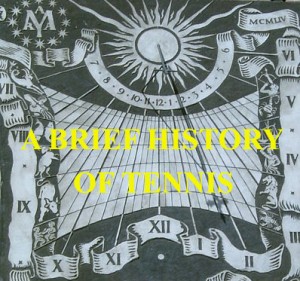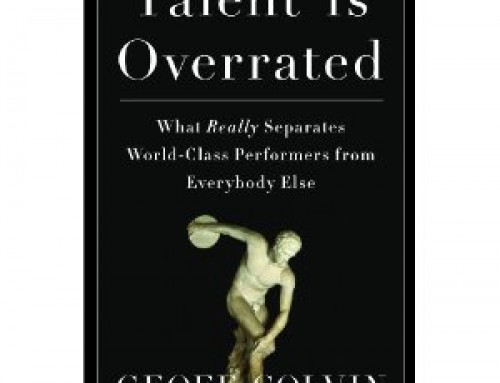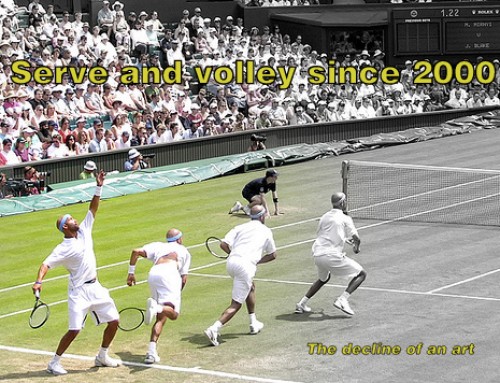 (*or the Ten Minute Tennis Time Capsule)
(*or the Ten Minute Tennis Time Capsule)
*Tennis in Ancient History – Some historians trace the origins of tennis before the year 1000 to the Egyptian town of Tinnis on the river Nile, and the origin of the word “racquet” to the Arabic word for palm – rahat. Stronger historical evidence tracks tennis to the crude handball game of 11th and 12th century French monks which later became known as jeu de paume or “game of the hand”.
*Tennis is Patented in 1874: Major Walter Wingfield issued a British patent for the game of tennis. The game spread in a matter of weeks through Britain, Ireland and other English-speaking countries. Wimbledon is launched in 1877. Dr. James White is credited with bringing tennis to the USA, and became known as the “Father of American Lawn Tennis”.
*The 1880s Through Early 1900s: The Renshaw Brothers (William and Ernest) from Britain dominate Wimbledon singles and doubles in 1880s. Richard Sears wins the first U.S. Open Championship in 1881. The Doughtery Brothers (Reggie and Laurie) also from Britain dominate tennis in the early 1900s.
*The Roaring 1920s – The Golden Age of Sport and The Tilden Era. “Big Bill” Tilden of Philadelphia dominates the sport, and is the first American to win Wimbledon, then goes on to play essentially undefeated from 1920 to 1926. Tilden helps popularize lawn tennis in America with books such as the classic The Art of Lawn Tennis, and later dominates the thinking of the sport with the book many consider his masterpiece Match Play and the Spin of the Ball. Tilden’s influence on the sport is unmatched, and he is voted by ATP Sportwriters as greatest player of half-century later in 1950. Other top stars of the day – Suzanne Lenglen and French Four Musketeers (Lacoste, Borotra, Cochet & Brugnon).
*The 1930s and 40s – The War Years. The Tilden Era makes way for the Budge Era – Don Budge invents the “Grand Slam” – winning all 4 majors – with one of the best backhands in history. Other top stars of the day were Ellsworth Vines (California USA), Bobby Riggs (also California) and Fred Perry (Britain). The game of tennis evolves into largely a baseline game, emphasizing ball control. WWII interrupts tennis growth.
*The 1950s Jack Kramer-Pancho Gonzales Era. The game sees the start of a professional player circuit. Pancho Gonzales rises to No. 1 in the world for a record-setting 8 years in the 1950s, and is generally considered the game’s greatest player. Maureen Connelly wins the Grand Slam on women’s side. The game evolves into the serve-and-volley enterprise. The top players develop a serve-and-volley as a quick and effective means to win points, games and matches on the grass courts which tennis was played on. Dr. James Van Alen opens the International Tennis Hall of Fame in 1954 in Newport, R.I. USA as a “shrine to the ideals of the game.”
*The 1960s: The Aussies Rule. “Rocket” Rod Laver, Ken Rosewall, Frank Sedgman, Lew Hoad, and Roy Emerson dominate on the men’s side, essentially carrying forward the serve-and-volley tradition. And for women, Margaret Smith Court dominates. Laver wins all four majors in 2 years, 1962 & 1969, thus becoming first man (and only man) to win 2 Calendar Grand Slams. Laver is widely regarded as the game’s greatest player, inheriting that mythic mantle from earlier champions Bill Tilden and then Pancho Gonzales.
*The Open Era: 1968 and Early 1970s – Tennis allows both professionals and amatuers to compete together in the Grand Slams, and thus the “Open” Era is born. Laver, Arthur Ashe and Billie Jean King dominate. Margaret Smith Court wins the Grand Slam. John Newcomb and Stan Smith for the Aussies continue the Land-Down-Under’s winning tradition. In 1973, Billie Jean King beats Bobby Riggs in the “Battle of the Sexes”.
*The 1970s: The Connors-Evert Era. Tennis undergoes revolutionary changes: The tiebreak is introduced at the U.S. Open in 1970, the Association of Tennis Professionals (ATP) is born and computer rankings are started. In perhaps the biggest single change in tennis in decades, wood rackets make way for metal rackets (example the Wilson T-2000), then graphite and composite rackets (example Arthur Ashe Head). Two new superstars emerge, defining the sport for the decade: the fiery Jimmy Connors and the stoic Chris Evert, employing a two-fisted backhand and flat-ball baseline game. The other great champion of the era is: Bjorn Borg who established a record, in a relatively short career, as one of the all-time greats. More than that, Borg became the first “rock-star” and mega-bucks tennis player.
On the women’s side, Czech Martina Navratilova, the all-time serve and volleyer emerged. Near the end of the 70s, New Yorker John McEnroe, also one of the all-time top volleyers begins to rise. Other highlights: Arthur Ashe wins Wimbledon in 1975. Tracy Austin wins the U.S. Open twice, first in 1979 and later in 1981. Tennis takes on a soap opera feel, with on-court (and off-court) characters such as “Nasty” Illie Nastase, “He-Man” Guillermo Vilas, “Party Animal” Vitas Gerulaitis. Some 30 million people, an all-time record, are reportedly playing tennis in the USA, then a nation of some 250 million.
*The 1980s: Tennis Evolves – The Bjorn Borg vs. John McEnroe battles became part of tennis lore, together with the great battles between Chris Evert and Martina Navratilova. For the women, Navratilova went on to win 18 Grand Slam singles titles through the 80s. On the men’s side, the Wimbledon Final in 1980 in which Borg defeated McEnroe in a 5 set thriller is considered one of the best ever. After Borg left tennis in 1983, new faces began to be seen: Swedes Stefan Edberg (serve and volleyer) and Mats Wilander (baseline wizard), and later German Boris Becker (another serve and volley artist).
Czech Ivan Lendl developed a power baseline game, and became the Number One in the world in the mid to late 80s. Lendl is widely considered to be the forerunner of modern “power tennis”. Meanwhile, on a parallel track, McEnroe, Edberg and Becker moved tennis into the serve-and-volley style. McEnroe’s serve-and-volley skills, in particular, helped establish him, by most critics, as the top doubles player of all-time. Meanwhile, in a trend that started in the 70s, more court surfaces transitioned over to hard courts, as 3 of the 4 Grand Slams began being played on one form or other of hard courts.
*The 1990s: The Sampras Decade – The 1990s produced the greatest player of his generation “Pistol” Pete Sampras and the ultimate serve-and-volley game. He dominated the decade amassing 14 Grand Slam singles titles and No. 1 rank for 6 straight years, with a fiercely determined but unassuming temperament. Sampras was widely thought to be the greatest player of all-time. His rivalry with Two-Handed Backhand Baseliner Andre Agassi, career Grand Slam winner, made for some of the great matches of the decade. Steffi Graf on the women’s side establishes herself as one of the all-time greats, with 22 Grand Slam singles titles, and both a Calendar and Golden Slam. Other notables: Jim Courier and Monica Seles.
*The 21st Century – The 2000s: The Federer/Nadal/Williams Era. The new century saw the emergence of yet more dominant players and the development simultaneously of the All-Court Game and the Power & Spin Baseline Game. Many fans, critics and commentators say that Swiss great Roger Federer, the human whip in perpetual “kinetic-chain” motion with his all-time 16 Grand Slam singles title record, may be the finest player that the sport has ever produced. His elegant all-court game with all strengths and no weaknesses may have taken the sport to a new level.
In contrast, the Spanish swashbuckler Rafael Nadal and his power topspin baseline game with 6 Grand Slam titles, Olympic Gold and Davis Cup for Spain, firmly places this play style on the front burner also. His game on clay is unsurpasssed, earning him the title “King of Clay”. The Nadal vs. Federer rivalry produced what many consider the greatest match of all-time in the 2008 Wimbledon Finals, a 5 set masterpiece won by Nadal in the evening hour darkness.
On the women’s side, the sister pair of Serena and Venus Williams has established a new standard for the power baseline game in women’s tennis. Serena has amassed 12 Grand Slam singles titles, and Venus 7 Grand Slam singles titles. Other notables: Justin Henin, with 7 Grand Slam singles titles and a magnificent all-court game and one-handed backhand, Andy Roddick, 2003 U.S. Open Champ with the fastest recorded serve, and rising stars Novak Djokovic and Andy Murray. The 2000s also saw technology advance further in tennis, with developments such as Hawkeye & Shot-Spot computer systems for player challenges, more retractable roofs such as that at Wimbledon and new powerful string technology.
By the 21st century, tennis had grown into a global sport, second only to soccer in popularity, with top players coming from around the world. The game’s top stars win millions in tournament prize money, enjoy multi-million dollar endorsement contracts and bask in world-wide celebrity status.
Why is study of the past relevant? Does the past teach us anything? An argument can be made that the past defines where we came from and how we got here. And even more important, the past can sometimes be a prelude to the future…
I have but one lamp by which my feet are guided, and that is the lamp of experience. I know no way of judging the future but by the past. Patrick Henry, March 1775
Timeless Tennis: A Blog
www.timelesstennis.net







